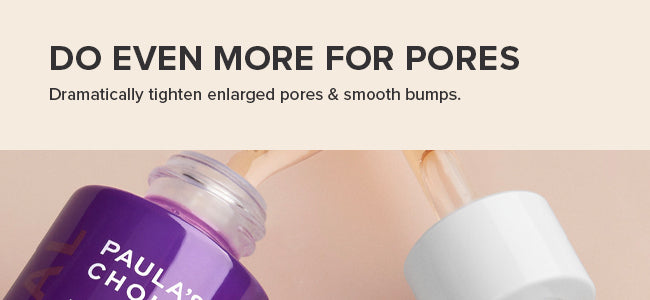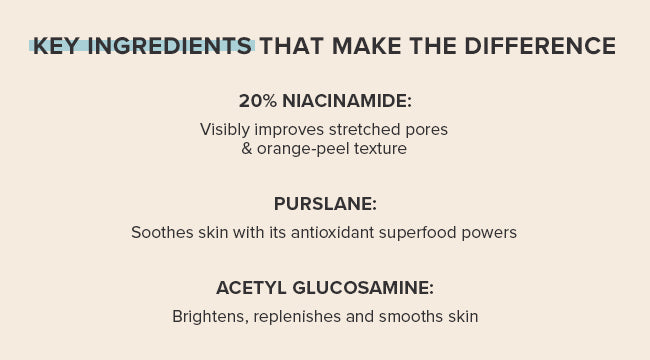Skin Concerns

Anti-Aging

Enlarged Pores

Oil Control

Uneven Skin Tone
Skin Types
Combination Skin
Dry/Very Dry Skin
Normal Skin
Oily Skin
This innovative serum is the first ever to contain niacinamide at a safe, effective 20% concentration. This advanced level, complemented by purslane and acetyl glucosamine, steadily smooths out rough, orange-peel texture and tenacious bumps.
All Paula’s Choice products are 100% fragrance free, clinically proven to be non-irritating, and never tested on animals.
2021 CEW Creators Award Finalist, Anti-Aging
Niacinamide (vitamin B3) is a smart, multifaceted ingredient that uniquely penetrates skin’s surface to help improve the look of sagging, stretched pores. It normalizes pore function and protects from further stretching when exposed to damaging UV light for a dramatically smoother, younger-looking complexion.
Apply a few drops of Niacinamide 20% once or twice daily after cleansing and toning. At night, layer with other treatment products as needed and follow with moisturizer; during the day, finish with a sunscreen rated SPF 30 or greater.




RECOMMENDED FOR YOU







Journal of Cosmetic Dermatology, January 2021, pages 304–309
Journal of Cellular and Molecular Medicine, September 2019, pages 6,203–6,214
Journal of Food Biochemistry, April 2019, ePublication
Journal of Pharmacopuncture, March 2019, pages 7-15
Experimental Dermatology, February 2019, pages 15–22
BMC Complementary and Alternative Medicine, January 2019, ePublication
Journal of Ethnopharmacology, March 2018, pages 132-137; and December 2016, pages 627-636
Cosmetics, February 2018, pages 10-11
Skin Pharmacology and Physiology, June 2014, pages 311-315
Cosmeceuticals and Cosmetic Practice, First Edition; 2014, pages 103-111
International Journal of Cosmetic Science, October 2013, pages 472-476
Key Ingredients
Niacinamide, Acetyl Glucosamine, Purslane, Licorice Root Extract, Spiraea Ulmaria, Camellia Japonica Leaf, Epigallocatechin Gallate
Product Ingredients
Water (Aqua), Niacinamide (skin-restoring/skin-replenishing), Pentylene Glycol (solvent/texture enhancer), Butylene Glycol (slip agent/hydration), Glycerin (skin-replenishing), Acetyl Glucosamine (skin-replenishing), Ascorbyl Glucoside (vitamin C/antioxidant), Glycyrrhiza Glabra (Licorice) Root Extract (skin-soothing/antioxidant), Spiraea Ulmaria (Meadowsweet) Extract (antioxidant), Portulaca Oleracea (Purslane) Extract (antioxidant), Camellia Japonica Flower Extract (antioxidant), Epigallocatechin Gallate (green tea-derived antioxidant), Boerhavia Diffusa Root Extract (skin-soothing), Camellia Sinensis (Green Tea) Leaf Extract (antioxidant), Allantoin (skin-soothing), Lecithin (skin-replenishing), Pullulan (texture enhancer), Panthenol (hydration), Silica (absorbent), Xanthan Gum (thickener), Sclerotium Gum (thickener), Propanediol (hydration), Sodium Phytate (chelating agent), Phenoxyethanol (preservative), Ethylhexylglycerin (preservative).
What’s the difference between the CLINICAL Niacinamide 20% Treatment and the 10% Niacinamide Booster?
Aside from the concentration of niacinamide (20% vs. 10%), the CLINICAL Niacinamide 20% has a slightly thicker texture. It also contains different supporting ingredients including meadowsweet, and camellia japonica to help reduce excess oil and offset pro-aging enzymes that can lead to stubborn, enlarged pores.
Should I use the CLINICAL Niacinamide 20% Treatment, 10% Niacinamide Booster or both?
You should use the Niacinamide 20% if you have advanced concerns such as stretched, sagging pores, orange peel-like texture, or stubborn oil-related bumps. If your concerns are enlarged pores and uneven skin tone, the 10% strength is ideal. If the intensity of your concerns varies over your entire face, you may want to try experimenting with both products.
Can I use Niacinamide 20% Treatment with other products containing niacinamide?
Yes, you can use the Niacinamide 20% Treatment with other niacinamide products including serums and moisturizers, layering them in order from thinnest to thickest texture. You can also alternate their use if you find that suits your skin’s needs.
Why did Paula's Choice formulate another niacinamide product?
The CLINICAL Niacinamide 20% Treatment was the brainchild of our founder, Paula Begoun. Having experienced such great results with the 10% Niacinamide Booster, she wanted to see if doubling the percentage would give her even better results on her most stubborn concerns (persistent clogged pores and bumps). Paula and team added some key supporting ingredients that really make this product a standout for anyone wanting to tackle large pores, rough, bumpy texture and uneven skin tone. The results exceeded expectations and the rest is history.
Can niacinamide cause sensitivity, redness or irritation?
Niacinamide typically doesn’t cause redness, sensitivity or irritation, although some people experience a brief flushing when pure niacinamide and vitamin C are used together. This combination can convert niacinamide to niacin, which may trigger temporary redness. Cosmetic chemists carefully formulate to avoid this concern, and even in a lab setting the conversion requires a significant amount of time and heat before it occurs. For those with a known sensitivity to niacinamide or with extra-sensitive skin in general, we suggest introducing the product slowly for the first two weeks, then increase gradually if desired.
Can I use niacinamide every day?
Yes, you can safely use niacinamide every day. Applying niacinamide products daily will provide the most consistent results.
Is niacinamide better morning or night?
For best results, you can use niacinamide in the morning and at night. You can also alternate its use if you find that works better for you.
What can you not mix with niacinamide?
While there are a lot of myths and misinformation about which ingredients you supposedly can’t mix with niacinamide, research shows that you can use niacinamide with retinol, vitamin C, hydroxy acids and other skin care ingredients safely.
Is 20% niacinamide too strong?
While 20% niacinamide is potent, the independent Cosmetic Ingredient Review Expert Panel has concluded that it is safe to use concentrations up to this amount. Individual responses may vary so if you have a known niacinamide sensitivity or extra-sensitive skin, we recommend patch testing first, and incorporating it slowly into your routine, watching how your skin responds.
What is “orange peel” skin?
Orange-peel texture refers to a condition where the skin appears thicker, has oversized (stretched) pores and an uneven, rough or bumpy texture like an orange peel. Learn more about orange peel skin in our article.
REVIEWS
 i
i i
i- Reviews
- Questions
Thank you for submitting a review!
Your input is very much appreciated. Share it with your friends so they can enjoy it too!
Highly recommend
I've repurchased this product many times because it's amazing at minimizing my pores and keeping my skin firm and bright.Additonally, I truly appreciate Paula's choice customer service team to keep me posted on deivery status and providing prompt responses for my questions.

helps lighten dark spots
it did helps lighten dark spots, reduce pore size over time, treat hyperpigmentation, redness, eczema, breakouts with my sensitive skin conditions and bright up my skin.









